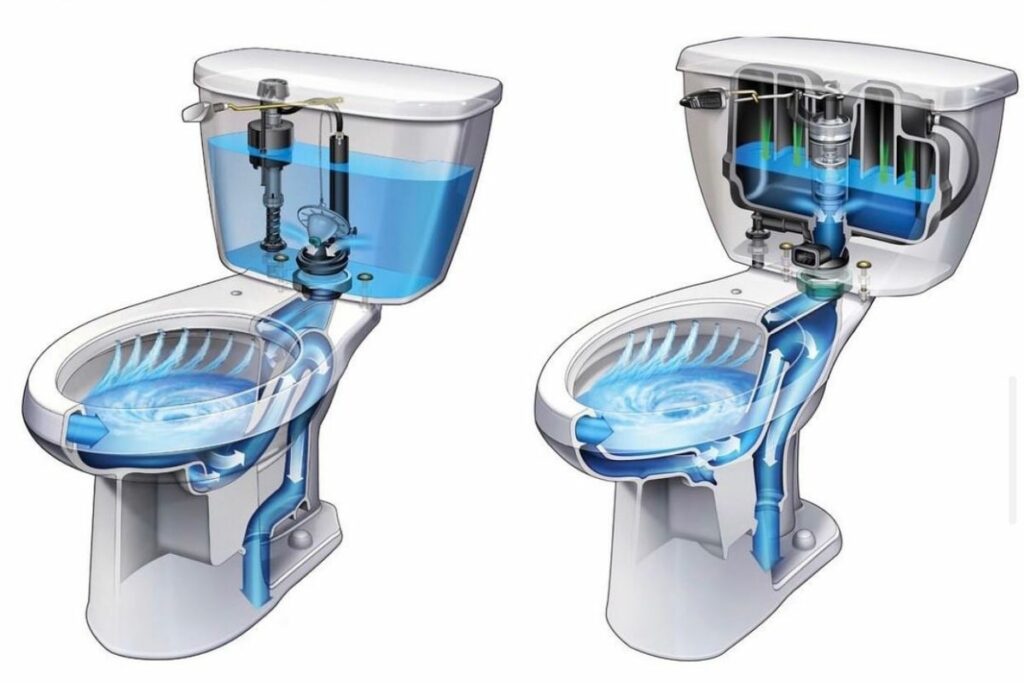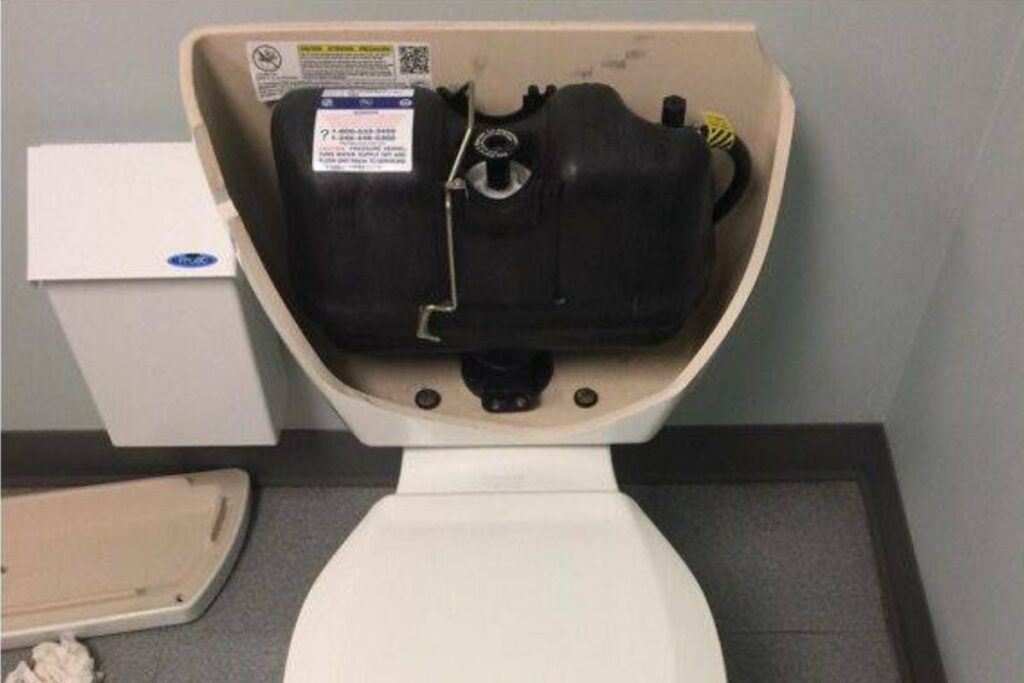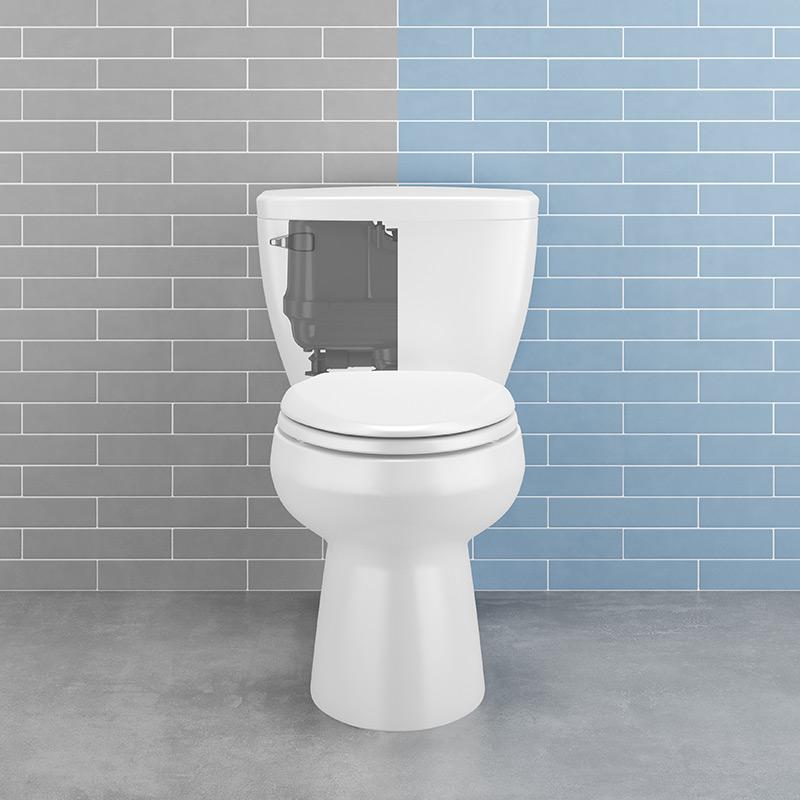There are two main types of toilets used in a home, regular toilets and pressure-assisted toilets. Pressure-assisted toilets are less common, and it’s not common knowledge how they work and what the advantages of them are. So, in this article, I will explain what a pressure-assisted toilet is, and the pros and cons compared to a regular toilet.
A pressure-assisted toilet has a special tank inside the water tank. The tank builds up air pressure without electricity, making a flush more powerful. A pressure-assisted toilet uses less water, but also provides a stronger flush than a regular toilet.
If pressure-assisted toilets offer these advantages, an obvious question would be why all toilets aren’t pressure-assisted toilets. Below, I will answer this question, and explain the pros and cons of a pressure-assisted toilet over a regular toilet.

Disadvantages of a Pressure Assisted Toilet
There are a range of advantages a pressure-assisted toilet has. So, what’s the downside? The one and only downside of a pressure-assisted toilet is they are louder than a regular toilet.
The difference in sound is not very large. On average, about 10dB. Sound engineers have reported that 5dB or less isn’t perceptible to the human ear. So, how loud a pressure-assisted toilet to a regular toilet is, is very minor.
This does make quite a difference if someone gets up to go to the bathroom in the middle of the night. When generally, a lot quieter than during the day.
Another, minor disadvantage of pressure-assisted toilets is some people have found that they can shred waste and toilet paper that can stay in the water after flushing. This occurs because the high pressure of the water entering the bowl breaks up the waste more than in a regular toilet. But, this appears to not be a common issue with pressure-assisted toilets.
Here’s a video that shows how a pressure-assisted toilet performs on just toilet paper, to see if it leaves small pieces of shredded toilet paper:
As you can hear from the video it is a bit louder than a normal toilet.
Advantages of a pressure-assisted toilet
A pressure-assisted toilet uses less water. This is an advantage because water does come at a cost. Estimates have found that a toilet accounts for about 20% to 30% of the total water used in a home. I explained this in more detail in this article about how much water a toilet tank holds.
It also explains if the water tank on a toilet is supposed to empty completely when it flushes. A regular modern toilet uses about 1.6 gallons (6 liters) of water per flush. Whereas, a pressure-assisted toilet uses around 1.1 to 1.2 gallons (4 to 4.5 liters) per flush.
A pressure-assisted toilet uses about 32% less water than a regular toilet. If we take the average amount of water used by a toilet in a home. This means a pressure-assisted toilet saves about 10% of the total water used in a home. Quite impressive.
Increased flushing power – need to use a toilet brush less

A toilet brush is there for a reason, when a person takes a poop there can be remnants on the sides of the bowl or in the bottom of a bowl. Overall, a regular toilet is very effective at completely emptying a bowl. But, a toilet brush can need to be used quite regularly. And/or a second flush can be needed to make the water in the bottom of the bowl completely clear.
The increased flushing power of a pressure-assisted toilet cleans the interior of the bowl much more effectively than a regular toilet. It also is far better at emptying the bowl completely and reduces the chances that you’ll need to double flush.
Less chance of a toilet clogging
A pressure-assisted toilet causes water to enter the bowl much faster. This breaks up the waste and forces it into the exit pipe. As you may have seen in the video above the weight of the water builds up and pushes the waste over the kink in the exit pipe. But, the force of the water entering the bowl also plays a role.

A pressure-assisted toilet moves the waste over the kink at a much faster rate. And reduces the chances it will get slightly stuck and then completely block itself as it travels down the exit pipe.
If you do run into an issue with your toilet clogging there is a way to clear it without a plunger. In case, you don’t have one on hand, read this article to learn how to clear a blocked toilet using only dish soap and hot water.
Does a Pressure Assisted Toilet Use Electricity
Many pressured tools use electricity to create increased air pressure. A pressure-assisted toilet creates quite a bit of pressure. So, here’s whether a pressure-assisted toilet uses electricity.
A pressure-assisted toilet does not use electricity. It has a tank inside the water tank for your toilet. This tank is empty and filled with air. As the water tank fills with water it builds up air pressure. Then when you flush the air pressure causes the water to enter the bowl much faster.

There are also vacuum-assisted toilets. These work in a similar way to pressure-assisted toilets. When the water level rises it lifts the top of a vacuum-assisted toilet. Then when you flush the top pushes down creating more water pressure.
Is a Pressure Assisted Toilet More Expensive
A pressure-assisted toilet is superior to a regular toilet for a number of reasons. And apart from a pressure-assisted toilet being louder, there aren’t any drawbacks. But, is a pressure-assisted toilet more expensive than a regular toilet?
As a general rule, a pressure-assisted toilet is not more expensive than a regular toilet. On average, both cost around $500. The good thing about a pressure-assisted toilet is that it doesn’t use any electricity or consumable products. Therefore, it also doesn’t cost any extra to use one.
A pressure-assisted toilet does have more moving parts. Therefore, there are more points of failure that can cause it to stop working. But, in general, all of the components in a pressure-assisted toilet will last as long as each other.

Amos Christen graduated with a bachelor’s degree in Interior Design from Drexel University — Philadelphia, PA. Since 2003, Amos has worked with top interior design professionals in this area, including architects and interior/graphic/lighting designers. As a skilled interior designer, Amos Christen is highly versed in fine arts and crafts and uses that to supplement his main area of expertise. He often publishes articles related to home décor on several websites, including Sprucetoilets.com, Sprucebathroom.com, and Mybesuitedhome.com. He also contributes to leading interior design magazines.
